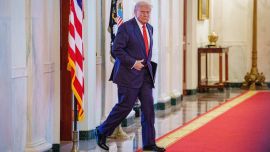Four days out from the presidential run-off, Argentina's Central Bank on Wednesday, began allowing micro-devaluations of the peso.
The official dollar exchange rate went from 365.50 pesos to 368.50 pesos, depreciating 0.81 percent during Wednesday.
The measure had been anticipated by ruling coalition presidential candidate, Economy Minister Sergio Massa, who projected a monthly three-percent devaluation of the legal tender at the official exchange rate.
Massa will face lbertarian lawmaker Javier Milei, whose main campaign proposal is to dollarise the Argentine economy and shutter the Central Bank, along with a drastic fiscal adjustment.
"That’s better in the face of 35-percent inflation over the last three months in which the official dollar didn’t move,” said economist Martin Kalos of the micro-devaluations.
On August 14, the day after the PASO primaries in which Milei emerged as the candidate with the most votes, the government devaluated the peso by around 20 percent.
Massa said the decision was taken in compliance with agreements from the US$44-billion credit programme the country has with the International Monetary Fund (IMF).
Ever since then, the official exchange rate has remained unchanged, but the parallel rate and the various other exchange rates have continued to rtise.
The “blue” or informal dollar, whose ups and downs impact price increases according to economists, rose on Wednesday by 4.8 percent, to 970 pesos per greenback.
The “CCL dollar,” for purchasing securities in pesos and selling them in dollars abroad, closed at 873.80 pesos.
The "MEP dollar", for purchasing assets in pesos which are then sold in dollars in the local Stock Exchange, closed at 882.35 pesos.
Argentina's Central Bank reserves have dwindled to dangerously low levels. Milei insisted on Wednesday to business leaders that Argentina's economic crisis, which includes runaway inflation at 142.7 percent per annum and a poverty rate of more than 40 percent, needs a "shock solution."
“If Milei wins, we have to wonder if he will move forward with his dollarisation proposal: to achieve that, there is no scenario that is lower than 3,000 pesos per dollar, with a risk of hyperinflation,” said Kalos.
– TIMES/AFP




















Comments